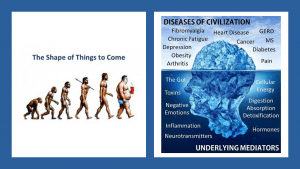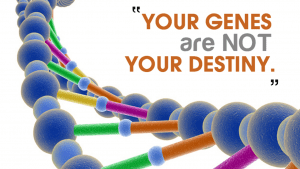High blood sugar levels are a consistent health-risk for many of us – whether or not we are ‘officially’ diagnosed with diabetes or pre-diabetes. This comes about primarily as a result of the foods a lot of us in industrialised society choose to eat.
These foods are mostly highly refined, non-fibre ‘foods’ containing refined sugars/corn syrups or a generally carbohydrate-laden diet – “high carb, low fat” – the so-called ‘wisdom’ of most nutritionists since the 1980s.
Sadly high blood sugar results in triggering the ‘fear & protection’ stress reaction of the body,
Fructose (fruit sugar) has more potent effects, but is rarely measured.
We have become “comfortable” and it is considered ‘normal’ eating toxic deficient foods
The following are the known effects that compromise our health and function:
1. Increased insulin production (until pancreatic fatigue due to insulin resistance – type II diabetes)
- High levels down-regulate immune function
- Provide free energy substrate for rapidly dividing cells (cancers)
- Leads to insulin resistance (see next page)
- Directly inhibits immune cell function
** Because glucose & Vitamin C are so similar in structure – leads to competitive inhibition on (all cell) phagocyte membranes (high sugar concentration displaces Vitamin C; but also reason why Vitamin C mega-dosing has been shown to be effective!)
** Vitamin C needed for phagocyte activation/proper function
(Blood sugar value of 120, decreases phagocytic index 75%)
2. Tissue glycation leading to advanced glycation end-products (AGEs) – VERY TOXIC
- Damage usually initiates a ‘scavenging’ (phagocytic) response – but when this occurs, leads to a potent inflammatory reaction
- in walls of arteries for example – leading to endothelial ‘cracks’ that allow small LDL fractions in etc.
- Also implicated in arthritis, headaches, and pretty much all other inflammatory diseases.
- Pro-inflammatory state of the body (+ PUFA ratio problems + acidity)
- When proteins are glycated this means more energy expended REPLACING consumed protein components (structural, etc.)
- Some proteins (such as collagen and nerve tissue) can’t be easily or quickly phagocytosed, leading to accumulation, and further cellular damage.
3. Increased Insulin production
- Increased insulin (sustained high levels) = a potent sympathetic nervous system activator
- Further maintaining stress response/stress hormone release.
- Decreasing cell-mediated immunity etc
- Increased levels of insulin = very mitogenic (leading to cell division)
- Mitogenic effects of insulin – stimulates cell proliferation/division in tissues that don’t easily become resistant – such as epithelia of vessel endothelium – leads to inflammation and plaque build-up (an ‘endothelial tumour’)
- Also increases general proliferation – possible increase in cancer (+ SHBG below, under liver change)
- By increasing rate of cell division this increases the ‘rate’ of ageing (when telomere/number of replications is used as measure of age)
- Increased blood clotting by increasing platelet adhesiveness.
- Increases conversion of macrophages into foam cells – also the cells that respond to and increase plaque formation.
4. Insulin resistance
** due to cells ‘protecting’ themselves via epigenetic down-regulation of both the number and sensitivity of membrane insulin receptors – “deafens them to the ‘shout’”
- Decreases Magnesium levels (normally, insulin would store this, and many other nutrients)
- ‘out in the urine’
- Decreases muscle relaxation, therefore further/sustained blood vessel constriction…further increases blood pressure
- Magnesium is a cofactor in almost all intracellular energy production – decreased cellular energy!
- Also used in production of further insulin!)
- Retention of Sodium – fluid retention (blood volume, pressure)
- also eating trans fats/hydrogenated fats which lead to cell membrane rigidity → further insulin resistance and easier weight gain etc)
- First tissue to become resistant = LIVER (most vulnerable to…)
More on the topic of insulin resistance can be found in our discussion of the 5 pillars of Chronic Ill-health.
5. Pancreas tries to overcome resistance by INCREASING production
- “increases the SHOUT”
- Leads to pancreatic fatigue (Type II Diabetes)
6. Changes to LIVER function (due to insulin resistance)
** in combination with the effects of both catecholamines and glucocorticoids (stress hormones)
- Decresed thyroid hormone conversion/activation
- Decreases T4 to T3
- Decreased growth hormone activation (via insulin-like growth factors/somatomedins)
- regulate/enhance HGH stimulating bone growth (osteogenesis)
- increased excretion of Ca2+ in urine
- Osteoporosis (is a pH and hormone issue, not a calcium issue)
- Dietary sources either get excreted and/or used buffering of acidic diet and /or that not excreted often laid down in other tissues as metastatic calcifications – arteries/tendons etc.
- Mediates blood lipids
- Raises smaller fractions of LDL (easiest to ‘get into endothelial ‘cracks’’ and also most easily oxidised)
- Helps control liver production of cholesterol – impacting ‘supply’ for sex hormones, vitamin d, cell membranes etc.
- Decreased sex hormone binding globulin production
- Bind and ‘transport’ or ‘escort’ sex hormones to appropriate target sites
- Lower levels mean ↑free sex hormone in bloodstream which is highly mitogenic (stimulates rapid cell division
- Combined with ↓immune function, chance of site-specific cancers is increased while under chronic stress.
- Because of resistance, liver continues to break down glycogen (especially while sleeping) further increasing blood sugar, and preventing fat burning as energy source (no fat loss!)
7. Muscle resistance prevents muscles from burning sugar!
What Does Chronically High Blood Sugar + Insulin Resistance actually mean?
- Type II diabetes
- Obesity
- Syndrome X, burnout, chronic fatigue
- Increased chance of cancer/heart disease/every other chronic illness.
Insulin is NOT “just” the blood sugar hormone – it is ANABOLIC (it signals the storage of all excess nutrients – sugar, fat and protein) and MITOGENIC (leads to rapid cell division)
Insulin levels dictate WHICH fuels are used for energy at any given time.
Insulin (sensitivity) beginning to be researched as a marker of human lifespan (longevity).
Glucose is first stored (but only very small quantities) as glycogen in Liver and Muscle
– then excess goes into fat as triglyceride saturated fat (palmitic 98% – heavily linked to heart disease)
The high carb, low fat model actually leads to storage of way more saturated fat – OXYMORON
All tissues (cells) do not uniformly become resistant to high levels of insulin
The Liver becomes resistant first, then muscle, and then fat.
However even with fat there is regional variation – which is why we get centripetal deposition of fat; between knees and bottom of ribs.













